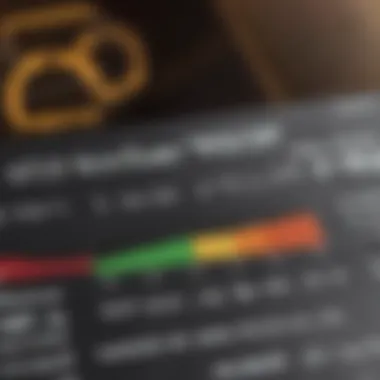A Comprehensive Guide to Unsecured Credit Cards


Intro
When stepping into the realm of personal finance, one encounters the concept of unsecured credit cards. These financial instruments differ quite notably from their secured counterparts; they carry their own sets of benefits and risks. For many, unsecured credit cards can be gateways to financial convenience, yet they can also pose significant challenges if not approached with caution. As we navigate this topic, we'll touch upon the inner workings of these cards, the various aspects of responsible usage, and the impacts on credit scores and overall financial health.
Understanding Loans
Loans often serve as the backbone of personal finance. In the broader financial landscape, the distinctions among various types of loans can be the crux of making sound financial decisions.
Types of Loans
- Personal Loans: Typically unsecured, these loans can be used for various needs like consolidating debt or making large purchases.
- Student Loans: Designed specifically to help students cover educational costs, they can come in both secured and unsecured forms.
Loan Eligibility Criteria
Eligibility often depends on several factors: credit score, income level, and existing debt obligations. For instance, lenders might look for a minimum credit score or a certain debt-to-income ratio to determine your viability for a loan.
Pros and Cons of Taking Out a Loan
Before diving into a loan, it’s wise to weigh its pros and cons.
Pros:
- Access to immediate funds
- Potential for lower interest rates with good credit
Cons:
- Risk of debt accumulation
- Possible impact on credit score if payments are missed
Navigating Credit Cards
Diving deeper into the world of credit, understanding credit cards is essential, particularly unsecured credit cards.
Types of Credit Cards
- Cashback Cards: These cards reward you with a percentage of your spending back.
- Rewards Cards: These offer points for travel or merchandise based on purchases.
Credit Card Utilization Tips
- Keep your credit utilization below 30% of your overall limit to maintain a healthy credit score.
- Set up automatic payments to avoid missing payment deadlines.
Avoiding Common Credit Card Pitfalls
Unsecured credit cards can be beneficial, yet they can easily lead one into a financial quagmire. Common pitfalls include:
- Overspending due to the allure of credit.
- Ignoring the fine print regarding interest rates and rewards.
"With great power comes great responsibility." - This adage rings particularly true in the context of credit utilization.
In closing, the journey through unsecured credit cards, loans, and financial products necessitates a solid understanding of not just how they function but also how to maximize their benefits while steering clear of potential traps. As we further delve into more specific sections, the aim is to equip readers with the knowledge to make sound financial decisions tailored to their circumstances.
Preamble to Unsecured Credit Cards
In the financial landscape, understanding unsecured credit cards can significantly influence an individual’s economic decisions. These financial tools provide an opportunity to build credit without the need for upfront collateral, making them accessible to a wider audience, including those who may not have substantial financial backing. Many consumers find them appealing due to their convenience and flexibility; however, they come with their own set of advantages and challenges that are essential to comprehend.
Defining Unsecured Credit Cards
Unsecured credit cards are credit lines issued by banks and financial institutions that do not require any form of collateral. Essentially, when you use an unsecured card, the lender is extending credit based solely on your creditworthiness. If a cardholder defaults on payments, the lender doesn't have collateral they can claim; rather, they rely on the borrower's promise to repay. This feature makes them a double-edged sword—on one hand, they allow access to funds without an upfront deposit. On the other, they present a risk both to lenders and borrowers. The typical credit limit varies based on several factors, including credit history, income, and even current debt levels.
Comparison with Secured Credit Cards
When weighing the merits of unsecured credit cards against secured options, it’s crucial to understand the fundamental differences.
- Collateral Requirement: Secured credit cards necessitate a cash deposit that acts as collateral, often the same amount as the credit limit. This upfront requirement means that borrowers have a way to guarantee repayment, which lowers risk for issuers. Unlike unsecured options, if the borrower defaults, the collateral can be claimed to cover the unpaid balance.
- Building Credit: Both types of cards can aid in building credit; however, unsecured credit cards generally allow for more significant growth in credit limits over time, assuming a good payment history. This can provide a stepping stone to better credit health, especially for those looking to improve their scores swiftly.
In summary, while unsecured credit cards offer a compelling option for many individuals to manage their finances and build credit, they come with certain risks and implications that one must carefully consider. Understanding these nuances not only prepares consumers for responsible use but also empowers them to make better choices in their financial journeys.
Mechanics of Unsecured Credit Cards


Understanding the mechanics of unsecured credit cards is essential for anyone looking to navigate the world of credit effectively. These cards offer a unique blend of flexibility and risk, making it crucial for consumers to grasp how they function to make informed decisions. In simple terms, unsecured credit cards allow individuals to borrow funds without requiring collateral, but this freedom comes with its own set of rules and considerations that can impact your financial health.
This section will cover the fundamental workings of these credit cards, how to acquire one, and the factors that influence credit limits, providing a comprehensive understanding essential for managing your finances.
How They Work: A Basic Overview
Unsecured credit cards operate primarily on trust and creditworthiness. When you apply for one, the issuing bank does not require a cash deposit; instead, your credit limit is determined based on various factors such as your credit score, income, and credit history. Unlike secured cards that require upfront collateral, unsecured cards pose higher risks for the lender, which is why they rely heavily on your credit reputation.
Here's a brief breakdown of the core mechanics:
- Credit Utilization: This refers to the percentage of your available credit that you're using. Keeping this below 30% is generally advisable to maintain a healthy credit score.
- Payment Terms: Each card includes specific terms regarding payment due dates and grace periods, which directly influence your interest accrual.
- Rewards Programs: Many unsecured cards come with perks such as cashback or travel points, further complicating the assessment of their actual value to the user's lifestyle.
"Understanding how an unsecured credit card operates can save you headaches down the road. Knowledge is power!"
Application Process for Unsecured Credit Cards
Applying for an unsecured credit card typically involves several steps that require careful preparation. First, review your credit report to check for any discrepancies. Knowing your score can give you an upper hand during the application process. Then, consider the types of unsecured cards available, weighing their rewards against any fees.
The generic steps in the application process include:
- Gather necessary documents: These usually include proof of income, a social security number, and existing debts.
- Submit an application: This can often be done online. Be prepared to disclose personal information, financial details, and your credit history.
- Wait for approval: Some issuers will give instant decisions, while others might take several days to review your application.
It’s not just about getting approved; it's about finding a card that fits your financial lifestyle. Don’t rush into any decision.
Credit Limit Assignments
Once you're approved for an unsecured credit card, the next factor to consider is how much credit you're actually granted. Credit limit assignments can be a game changer in your financial dealings. This limit often reflects the issuer's assessment of your ability to repay based on your credit score and income. Generally, higher credit scores can lead to more substantial limits, but that isn’t set in stone.
Several elements influence your credit limit:
- Credit Score: A higher score generally equals a better limit.
- Income Level: Your earnings play a significant role—higher income can lead to higher limits.
- Payment History: A solid history of on-time payments will improve your standing.
- Existing Debt: The more debt you have compared to your income, the lower your potential limit may be.
In some instances, issuers might offer initial limits that can be adjusted over time, so regularly engaging with your lender can be beneficial for your financial growth.
Advantages of Unsecured Credit Cards
Unsecured credit cards offer various benefits that can be quite advantageous for many consumers. Understanding these advantages is essential when considering financial strategies involving credit products. These cards can serve as a stepping stone towards building a solid credit profile while also affording flexibility in managing day-to-day expenses. Given the range of benefits, it’s worthwhile to explore the key aspects that underscore why they might be the right choice for some individuals.
Building Credit History
One of the standout features of unsecured credit cards is their ability to help individuals build or improve their credit history. When a person utilizes an unsecured card responsibly—for instance, by making payments on time and keeping balances low—this information gets reported to credit bureaus. Over time, this positive behavior translates into a stronger credit score.
This is particularly crucial for those who may not have an extensive credit background. Utilizing an unsecured card can pave the way for greater financial opportunities down the line, such as securing better loan terms or even qualifying for higher credit limits in the future.
Flexibility in Spending
Unsecured credit cards also provide a notable degree of spending flexibility. Unlike secured cards, which require a cash deposit that usually serves as collateral, unsecured cards allow users to spend without tying up funds upfront. This can be highly appealing for those who may need quick access to credit for unexpected expenses or larger purchases.
However, it’s essential to tread carefully. Just because access is easier, it doesn't mean overspending is advisable. A careful approach to managing this flexibility ensures that expenses remain within a planned budget, avoiding the pitfalls that come with higher debt.
Additional Benefits and Rewards
Unsecured credit cards frequently come packed with additional perks that can serve specific needs or preferences. These benefits often include cashback programs, travel rewards, and purchase protection options. When used wisely, these features can contribute significantly to overall financial wellness.
Cashback Programs
Cashback programs stand out for their simplicity and direct reward system. For each dollar spent, users can earn a percentage back, often varying based on the category of purchases—like groceries, gas, or dining out. The attractiveness of cashback lies in its immediacy; it feels like receiving a rebate on everyday spending.
However, it's important to note that while these programs can be a fun bonus, they shouldn't incentivize overspending. Keeping this in check allows consumers to enjoy the perks without straying into the territory of mounting debt.
Travel Rewards
Many unsecured credit cards offer travel rewards, which can be a significant draw for frequent travelers. These rewards can come in the form of points that can be redeemed for flights, hotel stays, or car rentals. The appeal lies in the potential to offset travel costs, making vacations or business trips more affordable.
Nonetheless, it’s crucial to understand the terms associated with these rewards. Certain cards may have restrictions or blackout dates that could diminish the perceived value of the points earned. Being cautious and informed about the card's terms ensures that the rewards are fully realized.
Purchase Protection


Purchase protection is another compelling feature often tied to unsecured credit cards. This coverage can safeguard recent purchases against theft or damage, offering peace of mind. Many consumers value having this added layer of security—especially for larger purchases.
However, as with any policy, the limitations and exclusions should always be reviewed. Not all purchases might qualify for this protection, and being aware of the specifics can avoid disappointment in times of need.
Overall, unsecured credit cards can present a variety of advantages that align with modern financial lifestyles. From building credit to enjoying rewards, they offer many benefits that, when managed wisely, can play a crucial role in a comprehensive financial strategy.
Drawbacks Associated with Unsecured Credit Cards
In the broad landscape of financially savvy decisions, understanding the drawbacks of unsecured credit cards is essential. While they offer flexibility and convenience, not all that glitters is gold. Consumers must recognize these pitfalls to mitigate the potential downsides that may come with these cards.
Higher Interest Rates
Unsecured credit cards often carry higher interest rates compared to their secured counterparts. This can create a slippery slope for individuals who live beyond their means or struggle to make timely payments. If a cardholder doesn't pay off their balance in full each month, the accumulated interest can become a hefty burden. For instance, if you have a balance of a $1,000 and an APR of 25%, the interest alone could result in owing about $250 in a year if you don’t pay it off.
It's crucial to scrutinize the terms of different cards. Not all interest rates are created equal, and some cards also feature promotional rates that may seem appealing but can jump significantly after the initial period. Always calculate the potential costs, and weigh that against your spending habits.
Potential for Overspending
Credit cards in general can lead to overspending, but unsecured cards may amplify this risk. The allure of having access to quick credit can make it all too easy to swipe without considering the long-term implications. In a moment of indulgence, you might rack up charges that could take months, if not years, to pay off. This tendency to overspend has the potential to snowball, leading to debt accumulation that could hinder financial well-being.
To counter this, setting a strict budget can serve as a useful safeguard. Consider employing the “envelope system,” where you allocate a set amount of cash for various spending categories, reducing reliance on credit.
Impact on Credit Scores
Using unsecured credit cards can have a significant impact on credit scores, for better or worse. On one hand, responsible use—like making timely payments and keeping balances low—can improve your credit profile. However, the opposite is also true. High utilization rates, which occur when you run up balances close to your limit, can ding your credit score.
Moreover, missed payments are reported to credit bureaus, further damaging your score. The long-term effects could influence your ability to secure loans for a home or car, leading to higher rates or even denial.
It’s a double-edged sword; therefore, understanding the effects of your spending habits on your credit report is crucial. Don't just fly blind; continuously monitor your credit health. As they say, "An ounce of prevention is worth a pound of cure."
In essence, while unsecured credit cards present tempting advantages, the drawbacks warrant a close examination. Knowing these challenges becomes critical for individuals keen on building a stable financial future, ensuring they stay on top of their game rather than be buried by debt.
Understanding Interest Rates and Fees
When navigating the realm of unsecured credit cards, it’s crucial to keep a close eye on interest rates and fees. These factors can have a substantial impact on your financial health over time. Understanding how these components function helps you manage your spending and play your cards right in the long run. After all, they can either enhance your financial flexibility or become a pesky burden that weighs you down. Lack of awareness around these elements can lead to nasty surprises on your monthly statements.
Annual Percentage Rate (APR)
The Annual Percentage Rate, or APR, is a core aspect of any credit card agreement. It represents the cost of borrowing money on your card, expressed as a yearly interest rate. This number isn’t just fluff—understanding it can save you from unintentional financial strain.
Typically, APRs for unsecured credit cards range widely, often starting around 12% and reaching as high as 30%. This variability is influenced by many factors including your credit score, the lender’s policies, and even the type of card you are applying for.
What’s crucial to grasp here is that the higher the APR, the more you’ll pay in interest on any outstanding balance. It’s like being caught in a sticky web; the longer you take to pay it off, the more tangled and expensive it becomes. To manage this variable, potential cardholders should shop around and consider cards with lower interest rates, especially if they anticipate carrying a balance.
Common Fees Associated with Unsecured Credit Cards
Perhaps even more daunting than the APR are the various fees that can crop up. These fees can sometimes sneak in, catching unaware consumers off guard.
Annual Fees
Annual fees are charges that some credit card issuers levy just for having the card. Depending on the card, these fees can range from zero to several hundred dollars. Some may see annual fees as a necessary evil, while others might question the justification behind them.
A key characteristic of annual fees is that they often correlate with the benefits the card offers. Cards with higher fees frequently provide more lucrative rewards programs, travel perks, or premium services. So, while the upfront cost can sting, the overall value may well counterbalance it in the long term. However, it's essential to measure the benefits against your spending habits to determine if a card with an annual fee is a worthwhile choice.
Late Payment Fees
Late payment fees come into play if you miss a bill payment deadline. Typically, these fees can run anywhere from $25 to $40 for your slip-ups. So, if you’re not careful, those missed payments can add up quickly, like snowballs rolling downhill.
The main concern with late payment fees lies in their double whammy effect. Not only do you pay a penalty, but your credit score can also take a hit, making future borrowing more complicated or expensive. To avoid this trap, set up reminders or consider automatic payments. A little planning can go a long way in keeping your finances on the straight and narrow.
Foreign Transaction Fees
If you enjoy traveling, beware of foreign transaction fees. These fees can pile onto your purchases made overseas, often ranging from 1% to 3%. Some cards even levy these charges on online transactions from foreign vendors, adding a layer of complexity that travelers might not foresee.
A significant feature of these fees is that not all credit cards impose them. Many travel-focused credit cards wave these charges as part of their appeal to globetrotters. For those who travel out of the country often, seeking a card with no foreign transaction fees can help save a good chunk of change over time.
Remember, awareness is key—understanding fees can turn the tide in your favor.


By recognizing and interpreting these various charges, you can significantly enhance your financial decision-making when it comes to unsecured credit cards, leading to more informed choices that align with your personal financial strategy.
Responsible Usage of Unsecured Credit Cards
Responsible usage of unsecured credit cards cannot be overstated, especially in today's world where credit can both empower and, if mishandled, deeply hinder financial wellbeing. When you look at these cards, it’s vital to not just think of them as a means to purchasing goods or services. Rather, they should be viewed as a financial tool that, if wielded wisely, can help build a sturdy credit profile and promote healthy spending habits.
Setting a Budget
Setting a budget is the foundation of responsible credit card usage. It's like preparing a map before a journey; without it, you're likely to get lost in a sea of charges and fees. The first step is determining your monthly income, and then outlining fixed expenses such as rent or mortgage, groceries, and any other must-have payments. Once you have this information, you can carve out a specific portion for discretionary spending, which may include credit card purchases.
Having a neatly defined budget simplifies decision-making. Instead of impulsively swiping your card at the store, you’ll be able to weigh each purchase against your budget. This helps in reducing the temptation to overspend, ensuring that you live within your means while still enjoying the benefits that come with the credit card.
Monitoring Spending Habits
Monitoring your spending habits is essential to ensuring that your credit usage remains responsible. This might sound a bit tedious, but it is akin to keeping an eye on the fuel gauge in your car; you don’t want to run out of fuel before you reach your destination.
There are numerous apps available today that can help with tracking your expenses. Some credit card companies even provide built-in tools that summarize your spending by category. Identifying spending patterns gives insight into where your money goes, allowing you to make adjustments when necessary.
Consider establishing a regular check-in schedule, perhaps every week or month, to review your transactions. This proactive approach not only keeps all those dollars in check but also makes you aware of the potential for savings in certain areas—perhaps cutting back on take-out dinners or those movie tickets might just free up some cash.
Paying Bills on Time
Paying your bills on time is perhaps the golden rule of credit card management. When it comes to unsecured credit cards, late payments can gnaw at your budget and wreak havoc on your credit score. Imagine sailing smoothly along, only to hit a rock due to a missed payment—it's not a fun ride.
It's wise to align your payment due dates with your paycheck schedule. Consider setting up automatic payments, ensuring that you never miss a due date—this way, it becomes a seamless part of your financial routine. Just make sure that the account you're drawing from has enough funds to cover the payment.
For those who might struggle to remember due dates, setting reminders on your phone or using calendar alerts can serve as handy nudges. Staying on top of these payments not only avoids nasty late fees but it fortifies your credit standing, allowing you to build a positive credit history.
"Understanding the tools at your disposal is crucial to achieving financial success; think of your credit card as a means to an end, not an end in itself."
In summary, responsible usage of unsecured credit cards can set you on the path toward financial health. By establishing a budget, monitoring your spending habits, and ensuring timely payments, you're not merely managing debt; you're building a financial strategy that works for you.
Alternatives to Unsecured Credit Cards
Choosing an unsecured credit card isn't the only route available for managing finances or building credit. There are several alternatives that one might consider, each with its own set of advantages and disadvantages. Understanding these options is vital, as they can provide a strategic approach to achieving personal financial goals. This section will delve into three prominent alternatives: secured credit cards, personal loans, and credit builder loans.
Secured Credit Cards
Secured credit cards are a popular alternative for those looking for a balance between access to credit and security. Unlike unsecured cards, secured cards require a cash deposit that acts as collateral. The credit limit is usually equivalent to the deposit amount. This means that while the risk for the lender is lower, users may have an easier time getting approved, especially if they have a limited or poor credit history.
Using a secured credit card responsibly can positively impact your credit score, much like its unsecured counterpart. By making timely payments and keeping balances within the limit, users can establish or rebuild a good credit profile. However, it’s important to know that not all secured cards come with favorable terms or features, so it’s essential to read the fine print before signing up.
Personal Loans
Personal loans offer another avenue for individuals looking to meet their financial needs without relying on credit cards. These loans can provide a lump sum amount that can be used for various purposes, like consolidating debt or financing a large purchase. The repayment terms typically range from one to five years, and borrowers make fixed monthly payments, which can aid in budgeting.
While personal loans often come with lower interest rates than unsecured credit cards, they usually require a good credit score for the best rates. For those with poor credit, the interest rates can be steep, making this option an expensive one. In addition, since personal loans require a full repayment of the principal plus interest, this may not be a suitable solution for everyone.
Credit Builder Loans
Credit builder loans are specifically designed to help individuals build or improve their credit. With this type of loan, the amount borrowed is usually held in a bank account while the borrower makes fixed monthly payments. Once the loan is paid off, the borrower then receives the original amount in a lump sum.
This strategy allows individuals to demonstrate their creditworthiness through consistent payment history, which can benefit their credit scores. Unlike traditional loans, credit builder loans are often easier to obtain for those with limited or poor credit history. Keep in mind, though, that these loans do not provide immediate liquidity since the funds are inaccessible until the terms are fulfilled.
Using alternatives to unsecured credit cards can ultimately lead to better financial choices. Choosing cautiously can help build a solid credit foundation without the typically higher risks that come with unsecured credit cards.
Epilogue: The Role of Unsecured Credit Cards in Financial Strategy
Unsecured credit cards are more than just plastic cards that let you tap and pay; they're pivotal in shaping one’s financial landscape. For many, these cards serve as a cornerstone of daily transactions and a vehicle for establishing creditworthiness. When assessing the role of unsecured credit cards in one’s financial strategy, it's vital to look at the multifaceted aspects they bring to the table.
Assessing Personal Financial Goals
Before diving into the world of unsecured credit cards, it’s crucial for individuals to reflect on their financial aspirations and circumstances. Are you aiming to build a solid credit history? Or perhaps you're looking for flexibility in managing monthly expenses? Unsecured credit cards can align with various personal financial goals, but they must be navigated with care.
- Building Credit History: For those starting out or trying to rebuild their credit, unsecured credit cards offer a prime opportunity. Regularly using the card and making on-time payments can significantly boost your credit score over time.
- Cash Flow Management: If handled judiciously, they can aid in managing cash flow during tight months. Being able to make purchases and pay them off later is a major advantage, provided one avoids falling into the trap of perpetual debt.
- Access to Rewards: Many unsecured credit cards come with rewards programs. If you’re savvy about your spending, you can leverage these rewards for benefits that align with your lifestyle, such as travel perks or cashback.
However, it's essential to weigh these goals against potential pitfalls. Being well aware of your financial ambitions can facilitate making informed choices about which type of card to pursue and how to use it effectively.
Making Informed Decisions
Knowledge is power. Choosing an unsecured credit card is not as straightforward as picking the first offer that comes your way. It requires a thoughtful evaluation of options, terms, and your personal spending habits.
- Comparing Offers: Take the time to shop around and scrutinize different offers. Focus on interest rates, rewards programs, and fees. Don't just settle for the surface appeal of a flashy advertisement.
- Understand the Costs: A clear understanding of the costs associated with an unsecured credit card can help prevent unpleasant surprises later. Annual fees, foreign transaction fees, or late payment charges can eat into your budget, so know what you're getting into.
- Utilizing Tools and Resources: Make use of websites and resources like Wikipedia, Britannica, or even forums like Reddit where personal finance topics are discussed. Educating oneself can offer valuable insights that facilitate better decision-making.







